The X Button
Dramatis Persona
by Todd Ciolek,

It's been over a month since SNK supposedly finalized the roster for The King of Fighters XIII. It now includes Kula, K', Vice, and many others, forming a lineup that's just as varied as the older The King of Fighters titles. Yet all of the characters have one thing in common: we've seen each and every one of them before.
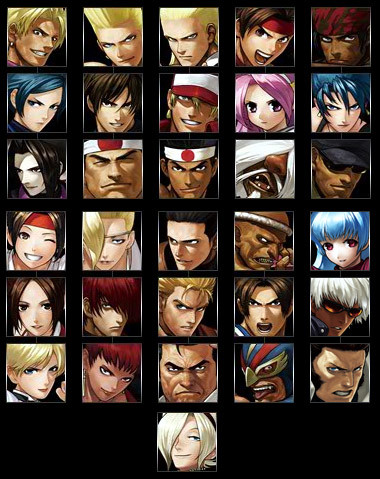
I hoped that SNK would add two all-new characters to join Ash Crimson there at the bottom, but it looks as though no one likes Ash now. With the game's Japanese release a few days away, it's unlikely that SNK will spring any more cast members on the public. The closest thing to a surprise here is the inclusion of Hwa Jai (the grimacing, vaguely Sagat-like kickboxer in the fourth row down, second from the right), who hasn't properly appeared in an SNK fighter since the original Fatal Fury.
The success of The King of Fighters XIII depends a great deal on its gameplay, of course, but I still think SNK's blowing it by stocking only familiar faces. Part of the fun of any upgraded fighting game comes from discovering new characters and learning just how they fare against the returning stars. And The King of Fighters once introduced fresh meat with every game. Now it's just spinning in place. Sure, Super Street Fighter IV only had two original combatants out of ten new spots, but that's two more than The King of Fighters has seen in a long time.
NEWS
THE LAST STORY FINALLY SHOWS ITSELF
Xenoblade's already out, the next big Final Fantasy is an online RPG, and no one yet knows what Dragon Quest X will look like. Yes, I think Mistwalker's The Last Story is the most important RPG coming to Japan this year, by default. A distinctly medieval-fantasy game in a genre that's increasingly techno-fantasy, the Wii-based The Last Story finds Mistwalker founder Hironobu Sakaguchi (I'm required by law to mentioned that he created Final Fantasy) taking another shot at the J-RPG big time. To his credit, The Last Story has impressive artwork, a good soundtrack, and appealing setting called Luli Island. And now, after months of teasing blog posts about the game, Nintendo finally put together a trailer.
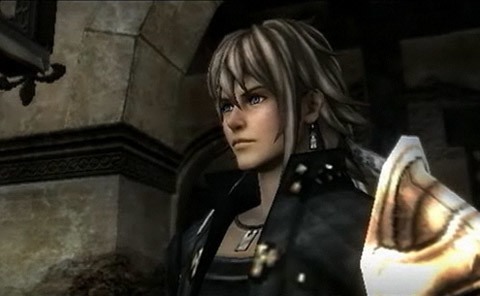
A lot of that trailer shows off the game's battle system and its surprising use of surrounding terrain, along with scenes that could've come from a more drably realistic version of Final Fantasy XII or a better-looking Valkyrie Profile 2. Also on display are a bunch of playable characters, including presumed hero Elza. Other character names were revealed in the battle-status display: the red-haired swordswoman is Seiren, the silver-haired thief is Yuris, and the dark-haired gentleman is Quark. The last few scenes in the trailer are reserved for the game's heroine, who hums before a sky of shooting stars. Like the hero, she lost her parents as a child, and, like the hero, she's ensnared in an island nation's war against an invading power. The Last Story's still on track for a vague “late 2010” release in Japan, which means North America won't get it until next year.
CYBERCONNECT2 ANNOUNCES TRIBUTE TO SPACE DOGS
Someone at CyberConnect2 likes dogs. That much is certain. The developer's first game was the charming (if clumsy) Tail Concerto, in which a dog-man piloted a police mecha. CyberConnect2 announced Solarobo, a sequel to Tail Concerto, earlier this year, and now there's another game waiting in their wings. It's called Strelka Stories, it celebrates CyberConnect2's 15th anniversary, and, just like Tail Concerto, it features dog-people.
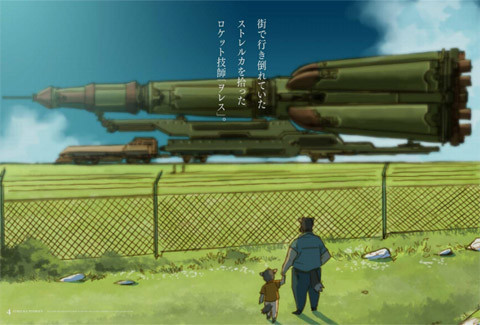
The Strelka Stories website divulges little about the game, but the name Strelka likely comes from one of Soviet Russia's space-faring dogs (unlike the ill-fated first space dog Laika, Strelka survived and had puppies). And these images of Strelka Stories are awash with dog-people and rocket technology, so draw your own conclusions. My own conclusion: it's set in a twisted world where dogs shoot humans into space and have them spayed or neutered. I'll assume this is true until CyberConnect2 says otherwise.
CAVIA DISBANDS, FOR REAL THIS TIME
Cavia had a rough life. Since its 2001 founding, the developer worked on many licensed games while occasionally striking out with something original. Nothing stuck, though; not the two Drakengards, not Bullet Witch, and not even Cavia's recent and relatively hyped Nier. Now Cavia, which was already partially absorbed into AQ Interactive several years back, is no more. Its staff is now part of AQ proper, though that company recently announced a freeze on all console-game projects.
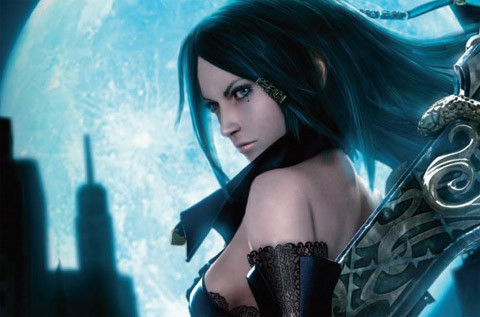
While Cavia's catalog disappointed and repulsed many over the years, they put together some enjoyable titles on the side, including the KORG DS-10 and a few decent-enough Naruto games. Cavia's Nier also had some novel game ideas, as the bestl ending deleted the player's save file. Considering AQ Interactive's current state, it might be a long time before Cavia's former members create another original game.
REVIEW: PERSONA 3 PORTABLE
 Developer: Atlus
Developer: Atlus
Publisher: Atlus
Platform: Sony PSP
Players: 1
MSRP: $39.99
Persona 3 sounds rampantly clichéd in curt descriptions. Really, it's an RPG about teenagers who explore demon-strewn dungeons when they're not wrapped up in the social minefield of high school. Yet the Persona series, along with the rest of the Shin Megami Tensei franchise, has long been a grotesquely unique island in a hackneyed genre. Persona 3 was such a success, in fact, that Atlus revamped it twice: once as the expanded FES edition on the PlayStation 2, and again as the considerably more revised Persona 3 Portable for the PSP.
Introductions are quick and surreal in Persona 3, as the player's abruptly cast as a transfer student at a high school in a seemingly normal suburban Japanese community. Before long, this unassuming student learns that his or her dormitory is a staging ground for warfare against the shadowy forces that arise during a hidden hour every midnight. This lost, demon-friendly time passes by most humans, but the player's avatar and most prominent classmates are all drafted into exploring a bizarre growing tower known as Tartarus.
The original Persona 3 cast a frequently distant teenage boy as the main character, with all of his options in studies, combat, and dating dictated by the player. Portable offers a choice between this semi-sullen hero and a new lead, a young woman with a more upbeat set of dialogue trees. Her story's slightly different and so are her relationships with those around her, even if the playable cast is the same: the friendly yet secretly troubled Yukari Takeba, the goofball Junpei Iori, the straight-faced Akihiko Sanada, the reticent Fuka Yamada, the precocious grade-schooler Ken Amada, the frequently unreadable Mitsuru Kirijo, and, of course, the android girl Algis. There's always a robotic one. And those are merely the player's party members. The school of Persona 3 offers dozens of other characters to befriend, along with clubs to join, courses to study, and other ways to surreptitiously improve your character's stats.
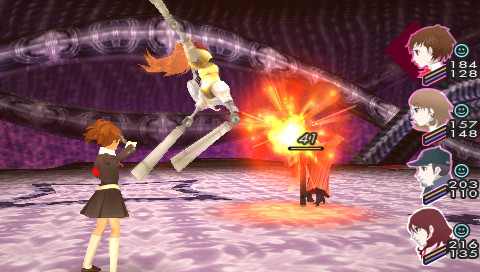
Beyond that, there's the imposing maze of Tartarus to explore. Its branching, randomly generated corridors start off basic and repetitive, but the layouts and enemies soon prove a challenge. Earlier versions of Persona 3 had players controlling only the lead character while the rest of the party spent the game's turn-based battles under the AI's usually sensible direction. Portable adds the option of controlling teammates directly, a feature that really should have been part of the game from the start. This PSP port also adds the chance to hunt for missing people in Tartarus, and even some vital supporting characters can disappear into the labyrinth.
Persona 3's combat is efficient, enjoyable, and, thankfully, doesn't occur at random. Players can surprise enemies before battle and make short work of them, provided the heroes are using Persona powers correctly. The backbone of gameplay here, the Persona entities are summoned when a character puts a handgun-shaped device to his or her head and pulls the trigger (a detail that would've single-handedly earned an M rating even if the rest of the game were squeaky clean). Each character has a standard Persona alter-ego, but new demonic avatars can be cycled in, upgraded, or even combined.
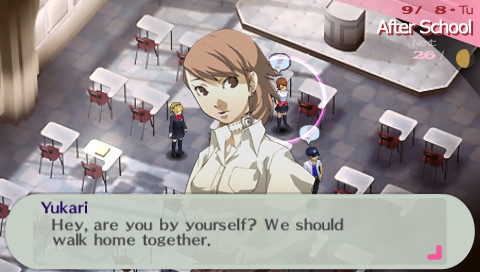
Back in 2007, Persona 3 drew a lot of attention for including a dating element and not completely embarrassing itself. In order to forge new powers through Social Links, players spend time hanging out with other characters, often helping them confront memories or psychological issues. There's a variety of different Links to discover in the game, and most of them change with the player's choice of protagonist. It's also woven into the game's larger world, one where studying, sports, and all sorts of typical teenage pastimes move the whole dating angle along.
Even if it stays above what many would dismiss as a “dating sim,” Persona 3 clings to genre trappings with its story. Most of the characters' motivations have familiar roots, and it takes a while for the game's more inventive points to emerge. Know how all sorts of RPGs, from Lufia II on through .hack//whatever, have the female lead panic in the midst of battle shortly after she's introduced? Well, guess what Yukari does in the game's first fight.
Yet it's the mixture of social life and dungeon hack that keeps Persona 3 above other RPGs. Raids on Tartarus break up the melodrama of the school day, and the game's network of relationships and diversions might just keep you from noticing that there's only one dungeon (albeit a huge one). Rarely does a game make you balance treks through a twisted maze with, say, time spent impressing the leader of the school's volleyball team, and even rarer is the game that does it with Persona 3's style and pacing.
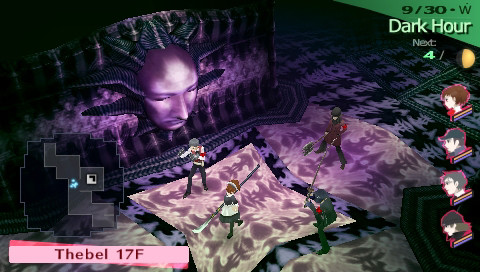
The question remains for returning players, of course: do you like Persona 3 enough to buy it yet again? Portable strongly leans toward a yes. Granted, it doesn't look quite as good as its source. While the Tartarus sections remain much the same, everything's pared down in the outside world. Conversations between the 3-D characters of the PlayStation 2 versions are now limited to cutouts throwing dialogue back and forth, and players navigate non-dungeon areas with a cursor instead of a moveable hero or heroine. Yet those are minor setbacks compared to the improved battle system and, most importantly, the heroine's storyline. She follows the same general path as her male counterpart, but her journey reveals new sides of various characters, and...well, she's more fun.
The game doesn't lose much else in moving to the PSP. The voice acting's as competent as it ever was, and the heroine even gets a largely new soundtrack for her half of Persona 3. Perhaps the only major absence is the “Answer” epilogue from Persona 3 FES, and I'm not sure why Atlus left it out, aside from some sense of fairness to the people who already bought the game.
It's hard to excuse buying three different versions of the same game, but then Persona 3 Portable excuses a lot. It broadens the original's storyline and greatly improves the battle system, making the game the excellent work it almost was in its previous incarnations. And even if it's missing a few extras, Portable is still the ideal place to start for newcomers or fans who want to justify a return trip. This might not be the definitive version of Persona 3, but it's arguably the best.
NEXT WEEK'S RELEASES
TRACKMANIA TURBO  Developer: Nadeo
Developer: NadeoPublisher: Dreamcatcher/Atlus Platform: Nintendo DS/Nintendo Wii Players: 1-4 MSRP: $29.99/$39.99 Next week has only a few releases, and none of them falls under this column's usual interests. So it's time to pick something outside of the norm. It came down to Trackmania Turbo or Samantha Swift and the Hidden Roses of Athena, and I don't trust myself to tackle a new Samantha Swift without first playing its predecessors. So it's Trackmania Turbo, the new DS update of a fairly popular racing series. Trackmania is big (particularly in Europe) due to its multiplayer attractions, but its best feature might be an elaborate track-editor, allowing players to build all sorts of courses just like they did in Excitebike all those years ago. This Turbo edition has 150 new tracks and three new environments, and, yes, a Wi-Fi option for facing players online. And if that's not closely related to these Japanese-cartoon things this site covers, you can always build a race track shaped like Naruto, the Gunbuster, or that duck from Princess Tutu.
|
discuss this in the forum (32 posts) |
this article has been modified since it was originally posted; see change history